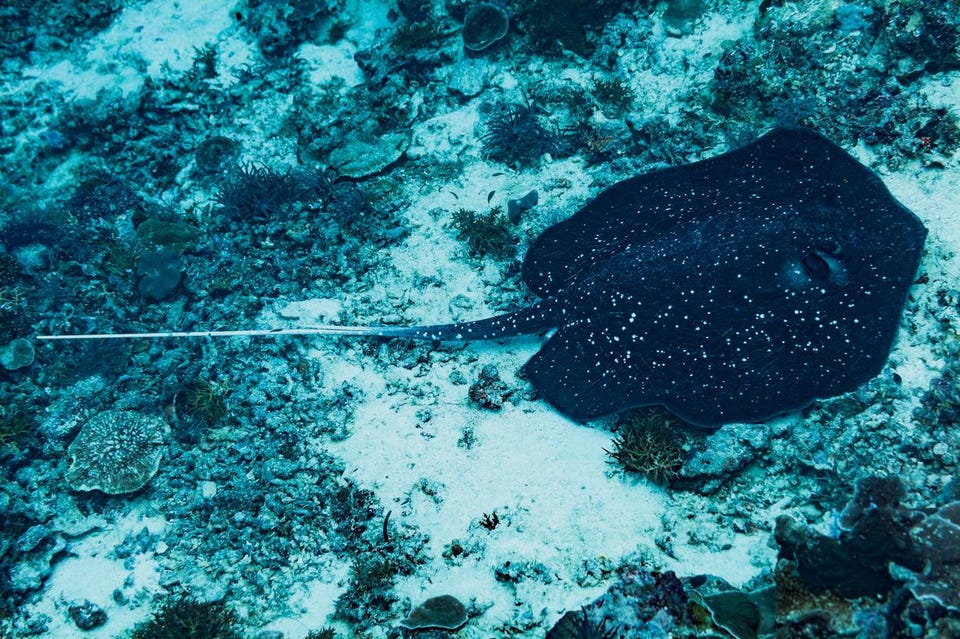Science Stingrays Make Sound! Melissa Cristina Márquez Contributor Opinions expressed by Forbes Contributors are their own. I write about the latest, exciting research on sharks worldwide! New! Follow this author to improve your content experience. Got it! Jul 24, 2022, 05:13am EDT | New! Click on the conversation bubble to join the conversation Got it! Share to Facebook Share to Twitter Share to Linkedin It has been long believed that stingrays are silent predators, but a new paper provides the first evidence of not one but two species of stingray actively producing sounds! Led by scientist Dr.
Lachlan C. Fetterplace of the Department of Aquatic Resources at the Swedish University of Agricultural Sciences (SLU), this finding was four years in the making. “I couldn’t believe my ears when I first heard this loud click clearly coming from the mangrove whipray I saw in the video [posted by scuba diver Philip Christoff ].
I immediately contacted Philip and asked if he’d be willing to share the raw footage so I could take a closer look. I had to have watched that video a hundred time. Slowing it down, speeding it up, zooming in.
I started digging through the published literature and internet pages, and I couldn’t find anything describing this behaviour so I knew it was something unique,” explained Dr. Joni Pini-Fitzsimmons of the Department of Biological Sciences at Macquarie University. The authors presented three examples of sound production by wild stingrays; one was an adult mangrove whipray ( Urogymnus granulatus ) in Indonesia by Philip Christoff, another was a juvenile mangrove whipray at Magnetic Island in Australia’s Great Barrier Reef by a biologist and photographer José Javier Delgado-Esteban , and an adult cowtail stingray ( Pastinachus ater ) in Australia’s Heron Island by marine biologist and photographer Johnny Gaskell .
“Given these observations were captured opportunistically by different people, we expect more to come to light in these and possibly other species,” said Pini-Fitzsimmons on her instagram post highlighting the new discovery. “If you’ve seen something similar, please get in touch!” Mangrove Whipray Urogymnus granulatus (The scientific name Himantura granulata is not accepted. ) .
. . [+] occurs in the tropicals Indo-West Pacific in a patchy but probably widespread distribution from Red Sea to Oceania in a depth range from 1-85m.
Max. diameter of the disc 141cm. Commercial fisheries occur for its meat, high value skin and cartilage.
This specimen was at the bottom at over 40m. As the photographer was diving on NITROX, the MOD, the maximum operation depth was at 34m. So how to take that photo? No flash, ISO 400 and the 100mm Makro.
Palau. Micronesia, 7°5’44. 089″ N 134°15’50.
59″ E at 40m depth getty Wondering if you’ve heard a stingray noise? Their sounds are short, sharp ‘clicks’ and the team believe they likely serve as a warning signal. “Both species often form large groups, so it may alert others to potential danger, suggesting a role in intraspecific communication!” explains Pini-Fitzsimmons. How these animals produce these noises is a mystery, although the scientists believe the are produced through rapid movement of the jaw or head and spiracles (an extra adaptation to help stingrays breathe while resting on the bottom of the ocean located near their eyes).
If you’ve ever stuck your head underwater and closed your eyes, you might have realized our ocean is anything but silent. It’s a symphony of sounds! And while whales are famous for their songs and sounds, almost 990 species of bony fish have been shown to actively produce sounds. Until this recent paper ( which can be seen here ), sharks and rays have been considered silent animals.
“This discovery opens up exciting new avenues for elasmobranch research and challenges what we thought we knew about how they communicate,” concludes Pini-Fitzsimmons. As the scientists debunk this misconception, they have highlighted that we humans have much to learn about life beneath the waves. .
. Follow me on Twitter or LinkedIn . Check out my website .
Melissa Cristina Márquez Editorial Standards Print Reprints & Permissions.
From: forbes
URL: https://www.forbes.com/sites/melissacristinamarquez/2022/07/24/stingrays-make-sound/
